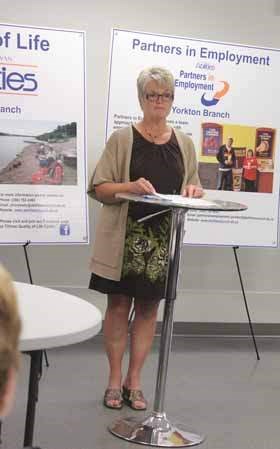After three years of planning, a new support program for the intellectually disabled in Southeast Saskatchewan was unveiled on July 25.
The Crisis Prevention and Support Program was designed "to support individuals with intellectual disabilities who are in a crisis," explained Cheryl Minke, the program manager of Saskatchewan Abilities Council's (SAC) Yorkton branch.
A crisis means that intellectually disabled individuals are in danger of losing their home placement and day program support. When situations escalate beyond what the agencies that work with them can handle, clients can be sent to mental health facilities away from home or law enforcement can be called, said Minke.
"We are going to try to avoid that," said Bob Martinook, a program director for Community Living Service Delivery (CLSD), a branch of the Ministry of Social Services.
Identifying a potential crisis early on is an important part of the program. Providing resources and training to community-based organizations and their staff is one way the program will help to prevent crisis situations.
For example, staff is trained to perform a 'rapid assessment' when called to client's residence. The first task is to find out what part of the environment is causing a problem. This could include the person's schedule, the lighting in their house or the activities they are doing. The next step is to calm the situation and help the person to cope with their problem.
The purpose of the prevention and support program is to offer a level of service that keeps the intellectually disabled who "have severe challenging behaviors" in their home community, explained Minke.
"The magic happens where the person lives. Saving a placement or providing supports so the person can stay in their place is what we really want to achieve," said Martinook.
Employees will also benefit from the program. Regional support staff will get relief from burn out caused by dealing with their clients' intense need for support. Providing support for employees is key to attracting and retaining people in the field, said Sue Sparrow of Rail City Industries.
The program will include seven staff, three of which are already hired. Two staff members will work out of Weyburn, with the rest working in the Yorkton, Rocanville and surrounding area. Staff will be dispatched to different areas in the region as needed.
Meetings between CLSD and community stakeholders over three years ago concluded that the region lacked the resources to deal with crisis situations. Working together, the group developed ideas into a plan for this project to help deal with that gap.
The Government is providing over $372,000 to fund the SAC as they operate the Crisis Prevention and Support Program.
This new program brings the total of Crisis Prevention programs in the province to three. The other locations are Prince Albert and the Waldheim-Hepburn area.
Thanks to a new position on the SAC, the province will know how much money these programs are saving as soon as December.
When the SAC decided they wanted to find a way to measure their value in communities. This measurement will help determine if programs were effective and areas where the organization can improve, explained Aleksandra Hober, Senior Social Impact Analyst for the SAC.
She started this new position three weeks ago after taking training, titled Return on Investment Analysis.
The analysis "allows you to be able to measure the social, environmental and economic impact of a program, policy, or organization," she explained.
Her research will look at who is impacted by the program, what type of outcome is achieved, and assign a dollar value to that outcome.
Because Hober needed help with assigning the financial cost of things like an emergency room visit, she partnered with the University of Saskatchewan for this research.
This project will create "knowledge and awareness of social return on investment across the province, said Hober.




